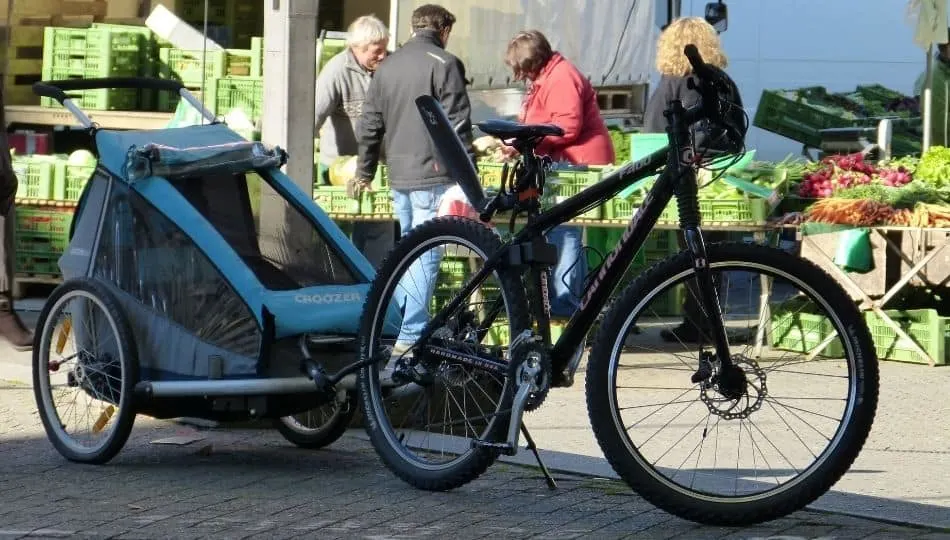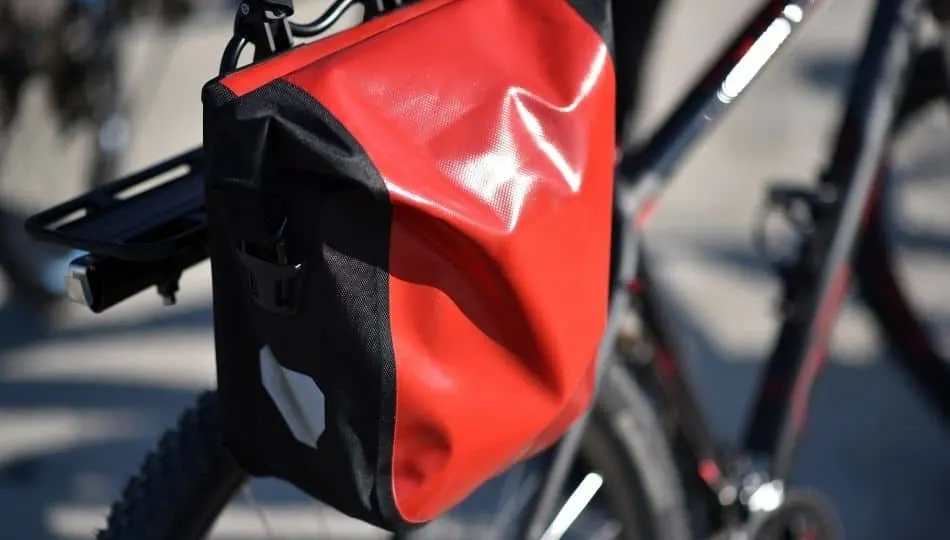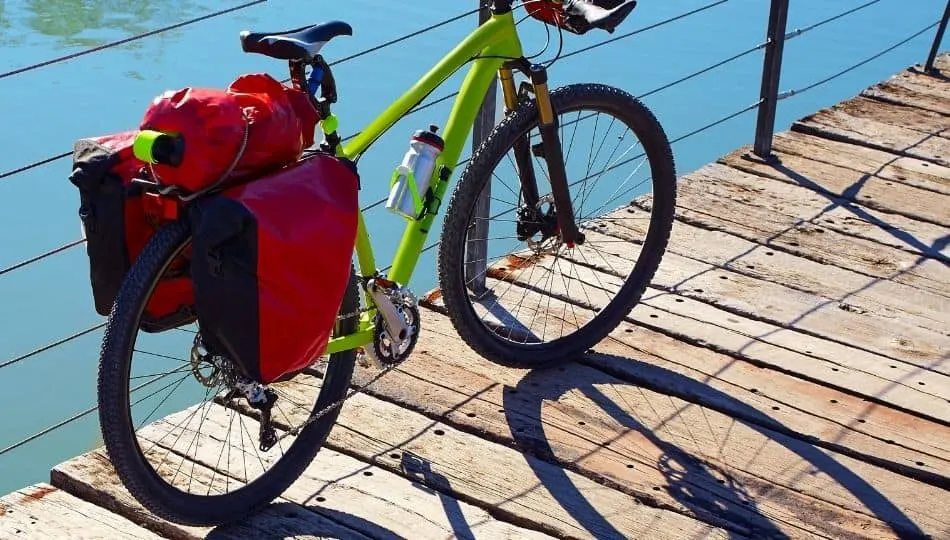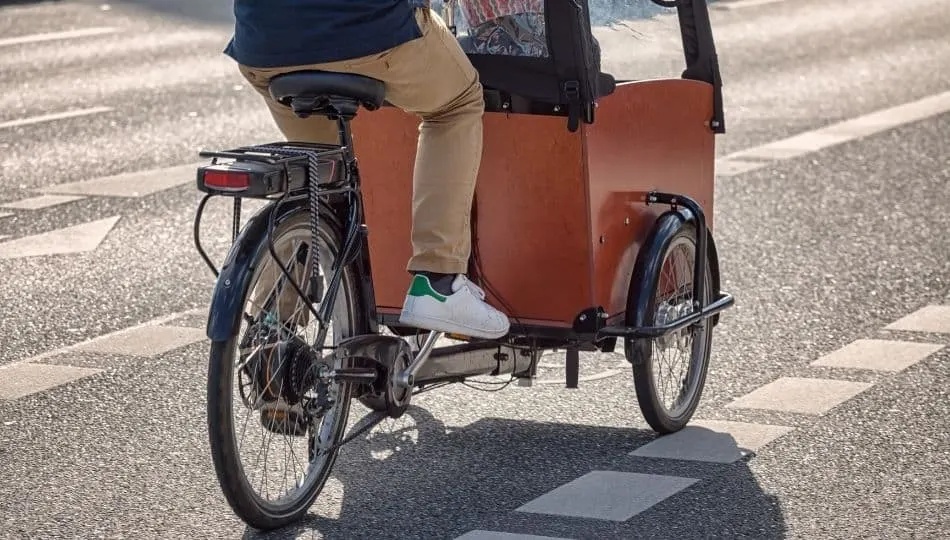
Bicycles are a fantastic way to couple an easy mode of transportation with a quality workout. However, the average bicycle isn’t built for carrying cargo as efficiently as cars or other vehicles. Fortunately, there are things you can do to carry significant amounts of cargo by just riding your bicycle.
Carrying cargo on your bicycle can be done in two ways. If this an occasional occurrence, you can invest in equipment such as luggage racks or panniers. Conversely, if you plan to carry heavy cargo loads daily, you could invest in a specialized bicycle, such as a cargo bike, for easy transportation.
Read on for a full guide on carrying cargo on your bicycle. This guide will help you determine which equipment is best for you and provide ample options from small bicycle accessories to cargo specialized bikes. We’ll also offer our top recommendations for each piece of equipment for additional ease.
Assess Your Cargo Carrying Needs
Before discussing the various types of equipment that make cargo carrying on a bike possible, it is important to assess your cargo carrying needs. This will help you determine which of the suggestions in this guide are best for you. You should assess three key factors before investing in cargo-carrying equipment for your bike.
- Frequency
- Weight
- Purpose
By considering these factors, you can find the equipment that best suits your needs quicker and more efficiently.
Frequency of Cargo Carrying on a Bicycle
If you plan to use your bicycle to carry cargo, consider first the frequency of this occurrence. Are you carrying cargo on a daily basis, a few times a week, or from time to time? How often you load-up your bicycle with cargo will alter what type of equipment you should acquire, partially based on the factor of installation.
For instance, if you rarely carry cargo on your bike, you’ll want something that’s easy to install and remove. On the other hand, if this is a daily occurrence, you can opt for equipment with a more permanent installation because you will always need it attached to your bike.
Weight of Cargo Carried on a Bicycle
Another important determining factor is the weight of the cargo loads you carry on your bicycle. Although bicycles can’t handle the same heavy loads like a car, they can still sufficiently carry cargo loads that weigh nearly 400 pounds, depending on their type and structure.
If this sounds like a weight capacity you need, it would be best to invest in a specialized bike, such as a cargo bike built specifically for this purpose.
However, if carrying 400 pounds sounds exceptionally high for you, then you can invest in a smaller piece of equipment, such as a bike basket or some panniers, instead.
Purpose of Your Bicycle When Carrying Cargo
The last factor you should consider for your cargo carrying needs is your bicycle’s ultimate purpose and when you would use it to carry cargo.
Bicycles can be very versatile pieces of equipment. You can use them as a leisurely mode of transportation, an extensive workout option, a gateway to sports, or an occupational necessity. Before you search for that perfect piece of cargo carrying equipment, reflect on your bicycle’s primary purpose and when you would use it for carrying moderate or heavy loads.
One instance would be if you typically use your bicycle for leisurely transportation or commuting and simply want equipment to help you carry your work supplies or materials for a social outing. This could be achieved with smaller equipment with a lower weight capacity and is easy to remove or install on a need-to-use basis.
Conversely, if your bicycle is used for long trips, forest/mountain trails, or to carry large loads for an occupation, you’ll want sturdier equipment that can handle the substantial weight and doesn’t detach easily.
You’ll also want to be conscious of your bike’s make and model before loading it up. Too much weight could affect your bike’s frame and your ability to ride, even for short distances.
Ultimately, the purpose of your bicycle should really drive your cargo carrying needs. If you want a bike you can ride around town while carrying heavy loads, you won’t want a specialized cargo bike. Instead, you’d be better off with a detachable bike trailer you can attach when necessary and when it isn’t on, you have ample freedom to ride wherever you want.
Bicycle Equipment for Cargo Carrying

Now that you’ve considered your cargo carrying needs as well as how often you are carrying cargo, the typical weight of your loads, and your bike’s primary purpose, you can choose the equipment that best suits your needs.
Below is a wide range of bicycle cargo carrying equipment. This list starts with equipment suited to smaller loads that are easily installed and detachable. It then progresses to equipment that can handle larger loads and may be harder to remove after installation. Finally, the list will end on specialized bicycles specifically built to carry cargo, as this ability is built into the structure of the bike.
You can also continue reading for a shorter list of cargo-carrying accessories that might assist in your cargo carrying endeavors and ensure maximum security of your loads.
Bicycle Equipment for Carrying Small Cargo Loads
To start, we’re going to discuss some cargo carrying equipment options that are best suited for smaller cargo loads that weigh up to 60 pounds. These are often inexpensive investments that are easy to install, detach, and make everyday bicycle rides easier.
Handlebar Bag
Cargo doesn’t have to be hundreds of pounds. It can also include small objects that are of minimal or exceptional value. The best way to carry small cargo that you want to keep a close eye on is with a handlebar bag.
Most riders will use these bags to store small everyday items, such as keys or wallets. They are typically attached snuggly underneath the front handlebars using Velcro or buckled straps, but larger bags will often lay in front of your handlebars. Others will lay on the front frame for bikes with limited space under or in front of their handlebars.
These bags don’t typically have many storage options since they are often made as one big pocket, but they are built with a zipper for the ultimate security of your belongings.
If you’re looking for a small piece of equipment that doesn’t affect your riding but allows you to keep an eye on the safety and security of your cargo, this is the primary option.
| Weight capacity | 5-7 pounds |
| Installation level | Easily installed and removed as needed |
| Average price range | $10-$40 |
| Best used for | Small, precious cargos |
| Top recommendation | ROCKBROS Bike Handlebar Bag |
Handlebar Basket
A classic choice for carrying small dogs on a leisurely bike ride, the handlebar basket has come a long way from its wicker woven origins. Nowadays, you can buy sturdy metallic mesh baskets or canvas baskets to help carry simple cargos you don’t need to protect from the elements.
The positive of this piece of equipment is that it is easy to strap or clip onto the front of nearly any bicycle and just as easy to remove. It also allows you to keep an eye on your cargo at all times to ensure its safety.
Unfortunately, handlebar baskets rarely come with lids, so if an unexpected storm rolls your way, you might risk the integrity of your cargo. Additionally, these baskets can have significant spaces or holes, so if you are carrying smaller, unsecured cargo, it might slip through your basket and be lost.
We recommend using this equipment for smaller bags or packages that need minimal protection and can’t possibly slip through the basket’s structure. They are also perfect for trips where you want quick and easy access to your cargo, so you can be on your way that much faster.
| Weight capacity | 20-50 pounds |
| Installation level | Easily installed and removed as needed |
| Average price range | $15-$65 |
| Best used for | Holding small bags, purses, or bundles you want to keep an eye on. Quick, easy access |
| Top recommendation | Retrospec Steel Basket |
Rear Basket
The rear basket is essentially the same as a handlebar basket, except it is located behind the biker’s seat and attached to the frame above your rear tire. This option is not as common as the front basket but still allows similar benefits and has the same shortcomings.
The most significant difference between these two options is that the rear basket is out of sight versus the handlebar basket keeps everything right in front of you. For precious cargos, you’ll want the handlebar basket. But for more common cargos you don’t need to fuss over or cargos that could potentially obstruct your view, you’ll be better off with a rear basket.

Fortunately, even though the basket is located behind you, it still allows for relatively easy access, just like the handlebar basket. This makes it an optimal choice for delivery jobs or putting up posters or flyers around town.
Another benefit of the rear baskets is they tend to be a bit bigger than the handlebar baskets because they have more space at the rear of your bike. A large handlebar basket would likely obstruct your front tire and inhibit mobility.
| Weight capacity | 30-60 pounds |
| Installation level | Easily installed and removed as needed |
| Average price range | $20-$70 |
| Best used for | Holding smaller cargo, you don’t want to obstruct your view |
| Top recommendation | Hoobbii Rear Basket |
Bicycle Equipment for Carrying Large Cargo Loads
If your goal is to carry cargo on your bicycle, odds are the cargo is substantial enough that it’s not going to fit in a small bag or basket. This means you’re going to need equipment structurally sound enough to handle heavier cargo loads.
The options listed below are tailored towards carrying heavier or larger cargo loads such as briefcases, duffle bags, backpacks, large packages, and more. Since this equipment is built to support large and heavier loads, they are often more expensive and more difficult to install and remove. Rather than straps and buckles, it is more likely you’ll clamp them onto your bike or screw them into your bike’s frame.
Therefore, these pieces of equipment tend to accessorize bikes for longer periods of time and are suited for individuals that carry heavier cargos frequently.
Rear Luggage Rack
When it comes to carrying larger or heavier cargo, the rear luggage rack is probably the most popular choice.
This piece of equipment is installed above your rear tire and typically screwed into your bike frame at the center of your rear tire. Installation is often easy and only requires you to attach about four screws to install your rack firmly and securely.
The rear luggage rack is the optimal choice for long trips or bulky items. Many riders will use these, so they don’t have to wear a backpack on a commute or store their items in various locations ahead of time.
A strong benefit of the rear luggage rack is that it is versatile because it allows you to attach additional pieces of cargo-carrying equipment, such as panniers. They are also optimally located to not inhibit your riding experience in the slightest.
An important note is that not all bikes can have rear luggage racks. Only bikes with braze-ons or threaded eyelets can accept a rear luggage rack, so make sure your bike is compatible before acquiring one of these.
You’ll also want to check what kind of brakes are on your bike before purchasing a rack. Disc-brake bikes must have a disc-specific rack since other racks will not be compatible.
| Weight capacity | 20-50 pounds (some models can reach a limit of 80 pounds) |
| Installation level | Medium installation requirement. More likely to be a permanent accessory. |
| Average price range | $30-$75 |
| Best used for | Heavier, bulky loads you want secure behind you |
| Top recommendation | SONGMICS Bike Cargo Rack |
Front Luggage Rack
Most individuals will choose the rear luggage rack before the front luggage rack, but this option has its benefits as well and can outshine the rear luggage rack in a number of ways.
Like a bike basket, the benefit of a front luggage rack is that it is located in front of you for ease of mind regarding your cargo’s safety and security. These racks are great for smaller bags, like a backpack purse, a laptop bag, or lunchbox, as well as small packages. Again, because they are located in front of the bike, they tend to be smaller than your rear luggage rack.
One reason many people will acquire a front luggage rack is for additional cargo capacity in addition to some of the other options on this list. Like the rear luggage rack, it also allows you to attach a pannier if desired, or it could help you support objects you might have in a handlebar bag or basket.
| Weight capacity | 15-40 pounds |
| Installation level | Medium installation requirement. More likely to be a permanent accessory. |
| Average price range | $60-$150 (there are some cheaper options in the $20 range, but typically, this is a pricier piece of equipment) |
| Best used for | Additional cargo capacity and support. Carrying small bags and boxes |
| Top recommendation | Origin8 Rush Messenger Front Flat Rack |
Bike Panniers

Another highly popular and versatile piece of cargo-carrying equipment is the bike pannier. Panniers typically come in a connected pair that can fit over your front or rear wheels and partially sit alongside your tires without affecting their functionality.
These bags are great for carrying various loose and/or small pieces of cargo you can’t place in a basket or secure onto a rack. You can also store medium-sized packages or bags in here that you want to protect from the elements during your ride.
Bike panniers tend to be another pricier piece of equipment because you typically get two, and they are often conditioned to be waterproof. However, in terms of protection and versatility for cargo-carrying, they are well worth the investment.
Another cost element to be aware of is that you typically need a front or rear rack to have panniers so they can clip on to your bike. Therefore, if you don’t already have one of these, this might be an even pricier investment for you.
Fortunately, once you have all the materials, these pieces of equipment are easy to install whenever necessary and are great for long trips and commutes. You could easily store drinks, snacks, emergency tools, and other small cargos in these bags without being concerned for their safety.
| Weight capacity | 25-40 pounds per pannier |
| Installation level | Easily installed and removed as needed |
| Average price range | $40-$80 |
| Best used for | Small, loose items. Weather protection. |
| Top recommendation | Ibera Bicycle Bag (Pair) |
Bike Trailer
Now we’re finally moving away from equipment that allows you to carry cargo on your bike and discussing equipment that allows you to carry cargo behind your bike.
A major concern for bikers that carry heavy cargo is that all the previous suggestions require this weight to be carried on your bike, in addition to it carrying your own weight. This could seriously damage your bike or shorten its lifespan. A fantastic alternative is to use your bike to carry your cargo’s weight behind you, and bike trailers allow you to do just that.
When people see bike trailers, they are often designed to accommodate little kids or even pets. On the one hand, if this is the “cargo” you are referring to, then you can find exceptional passenger and pet trailers for purchase, but, likely, you are here for a different kind of cargo.
Some bike trailers can measure around 28”x 33”x 22” and carry up to 125 pounds. That amount of room and the weight capacity is plenty to carry a series of large bags or boxes without risking the integrity of your bike.
Designs can vary from trailers with railed sides, where you’ll want to store large objects that won’t slip through the sides. Some have fabricated sides to ensure security, and others even come with tops for protection from the elements.
| Weight capacity | 80-125 pounds |
| Installation level | Moderate first installation (can leave hitch attached when not using trailer). Unlikely to be a permanent accessory. |
| Average price range | $100-$150 |
| Best used for | Large, heavy loads with multiple objects. Relieves weight and pressure on your bike caused by other options. |
| Top recommendation | Aosom Foldable Bike Cargo Trailer |
Specialized Bikes for Carrying Oversized Cargo Loads
In situations where you use your bike on a daily basis to carry numerous, large or oversized cargo loads, it would benefit you significantly to acquire a specialized cargo-carrying bike. These bikes are built specifically for carrying objects rather than sports or transportation.
It is unlikely you would use these bikes for anything but carrying cargo since they are structurally altered for this task. However, in the case of carrying specific cargos, like animals, you could opt for some of these choices for a leisurely ride over a bike trailer.
Cargo Bike
Also known as family bikes or box bikes, the cargo bike is perfect for individuals who carry oversized loads or numerous, large objects but want them to be located at the front of the bike for easy access.

These bikes can vary significantly, and most individuals will place animals or small children in the front storage section. However, you could easily carry varying degrees of cargo in these vehicles instead. There are even some instances where UPS delivery systems use cargo bicycles rather than cars. Although the storage for these bikes is typically in the rear rather than the front, if UPS uses them for cargo, you certainly can.
Alternatively, if you prefer to store cargo behind you on the bike, you could acquire a longtail cargo bike. This bike is structured a bit differently but allows far more modification options for maximum carrying capacity.
Rather than having a large storage section like of a cargo bike or trailer, the longtail cargo bike has an extended rear rack with one or two levels. This rack can be accessorized, like those previously mentioned, with panniers, crates, boxes, or other storage bags.
These bikes are exceptional for individuals going on long vacations and using their bikes for transportation versus a car.
It is important to note that what you gain in storage and cargo capacity with these bikes, you lose in speed and maneuverability. If you have an occupation where you need to move cargo quickly, you’ll want one of the previous options. But if you simply have to get as much as you can from point A to point B, either of these cargo bikes is the optimal choice.
| Weight capacity | 100-450 pounds (depending on model and type) |
| Installation level | No installation necessary other than accessories |
| Average price range | Cargo/family bike: $2,000- $4,000Longtail cargo bike: $1,000-$2,000 |
| Best used for | Large cargo loads. Cargo carrying is the primary purpose of your bike. |
| Top recommendation | Cargo/family bike: The Original – 2020 Edition or Longtail cargo bike: RadWagon 4 |
Bicycle Equipment Accessories for Cargo Carrying Assistance
Many of the pieces of equipment listed above are fantastic for carrying a cargo of all weights and sizes, but sometimes they need a little help. You can acquire various equipment accessories for minimal cost to ensure the safety and security of your cargo without buying more pieces of carrying equipment. Some of these accessories include:
- Cargo nets
- Rack straps
- Bungee cords
Most of these accessories will only cost you about $2-$10 and can make a world of difference in your commutes with hefty loads of cargo.
Cargo Nets for Cargo Carrying
Cargo nets are exceptionally beneficial when using a front or rear bike rack and will keep your cargo tightly secured to the bike. The net will stretch over the cargo and keep everything contained regardless of how fast you’re riding or how bumpy the terrain.
For additional ease, be sure these nets are equipped with hooks so you can connect them to and around your bike frame.
Rack Straps and Bungee Cords for Cargo Carrying
Rack straps and bungee cords also supply additional support, but they are best suited for one or two large objects you are trying to fasten to the bike, whereas the net can keep a collection of cargos secure more easily.
Regardless of the cargo-carrying equipment you have, these simple purchases are the best insurance policies you can have for ultimate cargo safety and ease of mind.
Final Thoughts
The capacity to carry cargo on your bicycle can vastly increase your cycling possibilities and even simplify the experience. These pieces of equipment, or specialized bikes, ensure you don’t need to strap on a heavy backpack or minimize your plans because you don’t have the space to carry cargo on your bike.
Now, with your new cargo-carrying capabilities, you are free to go on long trips, bring your furry friend or kids on rides, perform that new job with ease, and never again have to worry about how you’re going to transport your crucial cargo.
